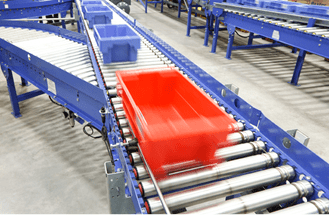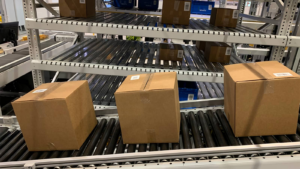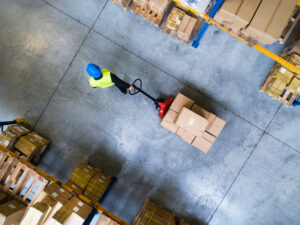The material handling and automation industry faces significant challenges and opportunities. The recent implementation of sweeping tariffs, including the 25% duty on steel and aluminum imports effective since February 2025, has sent ripples through our sector. As a trusted partner in conveyor systems, sortation solutions, and warehouse automation, Lafayette Engineering is committed to helping our clients navigate these changes while maintaining operational excellence.

The Tariff Impact on Material Handling and Automation
Rising Costs and Supply Chain Disruptions
The current tariff environment is significantly impacting the conveyor system industry, with key components like belts, rollers, driving units, and control systems sourced from overseas now subject to higher costs. This directly affects both manufacturers and end users in our industry.
For warehouse automation specifically, the 25% U.S. tariff on steel has a direct effect by significantly increasing the cost of equipment, since most warehouse systems—including robotics, conveyor belts, and storage infrastructure—rely heavily on steel. These cost increases are affecting both domestic and international vendors as demand for U.S. steel rises.
Innovation and R&D Challenges
Higher operational expenses are limiting investments in developing advanced conveyor technologies such as automated storage and retrieval systems (AS/RS) and sensor-driven operations. Companies throughout the material handling sector are reevaluating their R&D priorities in light of tariff-induced cost pressures.
Operational Timeline Extensions
Projects are already experiencing longer planning-to-implementation timelines. According to Dodge Construction Network, the median time for nonresidential projects to move through planning is 6.5 months longer in early 2025 than in 2019. This extended timeline affects facility upgrades, expansions, and new automation implementations.
Strategic Responses for Material Handling Companies
1. Automation as a Counterbalance to Tariff Costs
One of the major advantages of investing in automation is its ability to reduce a manufacturer’s dependence on foreign suppliers. By producing automation systems and parts domestically, manufacturers can avoid the rising costs caused by tariffs on imports. This approach not only helps manage costs but also creates a more resilient supply chain.
Automation also improves operational efficiency. Smart conveyor systems, robotic process automation, and AI-driven logistics help streamline workflows and maximize output, enabling companies to maintain high efficiency even when facing higher material costs.
2. Supply Chain Resilience and Diversification
To navigate tariff uncertainty, businesses should adopt a multifaceted approach that integrates supply chain optimization, legal compliance, and financial strategies. Reshoring and nearshoring—bringing production closer to key markets—reduces tariff exposure and enhances supply chain resilience.
For material handling equipment providers like Lafayette Engineering, this means evaluating component sourcing strategies and potentially developing stronger relationships with domestic suppliers or those in countries with favorable trade agreements.
3. Technological Integration for Better Decision-Making
Industrial manufacturers are using technologies and digital solutions to enhance operational and supply chain resilience and increase visibility across the value chain. Digital twins of the supply chain for essential components can assist in identifying alternative suppliers or boosting robustness and agility to reduce dependency.
At Lafayette Engineering, we’re implementing advanced analytics and digital tools to help our clients monitor supply chain risks, optimize inventory levels, and make data-driven decisions about equipment investment and maintenance schedules.
4. System Optimization and Retrofitting
At Lafayette Engineering, we’ve been synonymous with innovation and service in the automation and material handling industry. Even the most expertly crafted conveyor system can benefit from improvements over time.
In the current tariff environment, optimizing existing systems makes more economic sense than ever. Component upgrades, maintenance optimization, and strategic system modifications can extend equipment life while avoiding the full impact of tariff-inflated costs on new equipment.
Industry-Specific Opportunities
E-commerce and Retail
Understanding emerging trends in the material handling industry can help boost productivity while keeping costs down. Automation is one of the major trends, driving industry growth to new heights as automated systems perform repetitive tasks quickly and accurately, reducing labor costs while better utilizing human workers.
For retailers and e-commerce companies, the right automation investments can offset tariff-related cost increases through improved operational efficiency, reduced labor costs, and enhanced order accuracy.
Manufacturing and Production
With tariffs on steel and aluminum imports, many manufacturers are reassessing their supplier networks and increasingly turning to automation, AI-driven production planning, and additive manufacturing (3D printing) to offset rising costs. These technologies help reduce material waste, improve efficiency, and streamline operations.
Lafayette Engineering’s expertise in controls engineering and automation solutions positions us as an ideal partner for manufacturers seeking to optimize production flows in response to new economic pressures.
Logistics and Distribution
As tariffs add complexity to supply chains, more companies are outsourcing logistics to third-party logistics providers (3PLs) that specialize in managing trade-policy shifts and supplier diversification. This trend is driving greater adoption of automation by 3PLs, particularly those handling cross-border trade.
Our experience with sophisticated sortation systems, conveyor solutions, and warehouse control systems enables 3PLs to adapt quickly to changing trade regulations while maintaining high service levels.
Lafayette Engineering’s Approach to the New Tariff Environment
As outlined on our website, Lafayette Engineering combines extensive electrical engineering capabilities with the latest in technology and control devices to improve equipment utilization, increase system efficiency, reduce operational costs, increase productivity, and provide flexibility with material handling systems. These core strengths position us perfectly to help clients navigate tariff challenges.
Our approach includes:
- Comprehensive system audits to identify opportunities for efficiency improvements and cost reductions
- Custom solution development tailored to each client’s unique challenges
- Domestic sourcing strategies that reduce tariff exposure while maintaining quality
- Advanced controls integration to maximize the performance of existing equipment
- Strategic consultation on automation investments with the highest ROI in the current economic environment
Conclusion
While the current tariff landscape presents challenges for the material handling and automation industry, it also creates opportunities for companies that can adapt quickly and strategically. By focusing on domestic production, technological innovation, system optimization, and supply chain resilience, businesses can not only mitigate tariff impacts but potentially gain competitive advantages.
Lafayette Engineering remains committed to providing cutting-edge conveyor systems, sortation solutions, and controls engineering that help our clients thrive regardless of economic conditions. By partnering with us, companies can transform today’s challenges into tomorrow’s opportunities for increased efficiency, reduced costs, and enhanced operational capabilities.
Contact Lafayette Engineering today to discuss how we can help your business navigate the new tariff environment while building a more resilient, efficient, and future-ready material handling operation.


